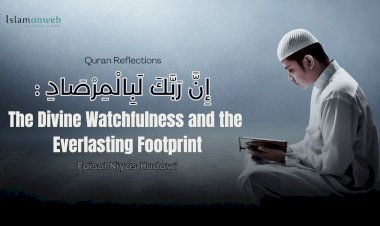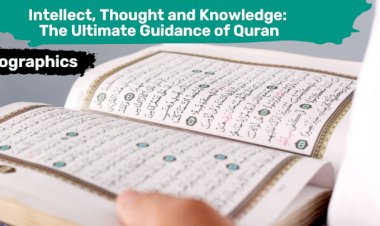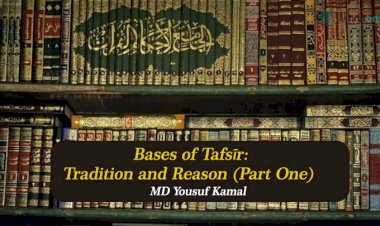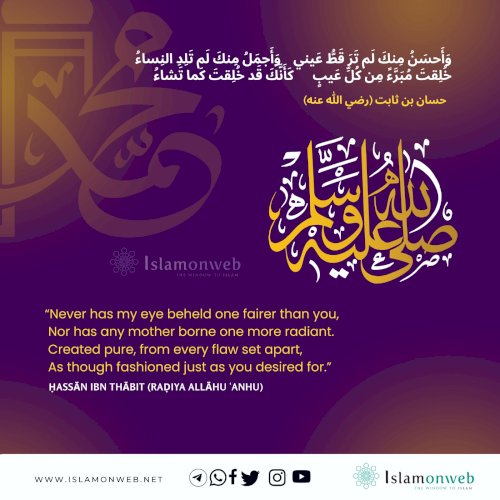The Evolution, Trends, and Benefits of Modern Tafsir: Its Importance in the Contemporary World
The Qur'an is the eternal source of divine guidance. Across centuries and continents, it has shaped communities rooted in tawḥīd and unity—communities that uphold human dignity not through wealth, lineage, or race, but through one's connection to Allah and the presence of taqwā. Its preservation is not a human endeavour but a divine guarantee. As Allah declares:
“Indeed, it is We who sent down the Qur’an, and indeed, We will be its guardian.” (Sūrat al-Ḥijr, 15:9)
This assurance frees the ʿulamāʾ from the responsibility of preserving the Qur'an’s text; their task is to serve as the Prophet’s heirs in interpreting its meaning and guiding its application in ever-changing contexts.
The emergence of various Islamic sciences is a testament to the dynamic role the ʿulamāʾ have played in addressing the spiritual and intellectual needs of their times. After the passing of the Prophet Muḥammad ﷺ, the efforts to compile the Qur'an and the Hadith marked a significant phase in safeguarding and systematising the foundational sources of Islam. This was not done as a mere archival exercise but to make the guidance of revelation accessible and applicable for the generations to come.
Tafsīr, the interpretation of the Qur'an, developed within this same spirit. Initially, it was closely linked to ḥadīth studies, relying on the Prophet’s ﷺ own explanations. Over time, however, tafsīr matured into a distinct discipline. Its trajectory reflects a continual effort to understand and apply the Qur’an’s meanings in the light of emerging questions, social realities, and intellectual challenges. Through the centuries, different approaches emerged—tafsīr bi’l-maʾthūr (reliance on transmitted reports) and tafsīr bi’l-raʾy (reasoned interpretation) among them—each adding depth to the tradition of Qur'anic exegesis.
This study primarily centres on modern tafsīr while drawing on classical interpretations to offer a more comprehensive understanding of the subject. It aims to highlight the relevance and significance of contemporary exegesis in addressing the pressing challenges of our time.
The emergence of Major Classical Tafsirs
Although the Qur'an was revealed in eloquent Arabic to an audience familiar with its language, the complexity of its meanings, coupled with social norms and educational limitations, led even the earliest Muslims to seek deeper explanations of its verses. As Islam expanded beyond the Arabian Peninsula and encountered new cultures, theological debates, and political dynamics, the need to interpret the Qur’an within these evolving contexts became increasingly evident. Moreover, the natural development of the Arabic language over time required scholars to clarify and contextualise Qur’anic terms and expressions across generations.
One of the Prophet’s ﷺ essential roles was to explain the Qur’an through his sayings and actions. After his passing, many of the Companions—such as ʿAbd Allāh ibn Masʿūd, Ubayy ibn Kaʿb, ʿAbd Allāh ibn ʿAbbās, and Zayd ibn Thābit—became key figures in interpreting the revelation. Within a century and a half after the Prophet’s ﷺ death, particularly towards the end of the Umayyad period, scholars began to compile full-fledged tafsīr works, primarily based on transmitted narrations.
In its early phase, tafsīr relied heavily on historical reports to elucidate meanings—a method known as tafsīr bi’l-maʾthūr (interpretation through transmission). This approach drew upon statements (matn) attributed to the Prophet ﷺ, his Companions (al-Ṣaḥābah), and their successors (al-Tābiʿūn). These narrations were considered authoritative, and their credibility was assessed through meticulous scrutiny of the isnād (chain of transmission), the integrity of narrators, and other critical criteria. Alongside sound prophetic reports (ḥadīth) and historical context (sīrah), early exegetes sometimes included less rigorously verified narratives, particularly from Judeo-Christian traditions, referred to as Isrā’īliyyāt.
By the eleventh and twelfth centuries, tafsīr had diversified, reflecting broader intellectual currents in the Muslim world. Philosophy, dialectical theology (kalām), jurisprudence, and mysticism began to shape new approaches to Qur’anic interpretation. These intellectual streams gave rise to landmark classical works, each rooted in its own methodology and worldview. Notable among them are:
- Jāmiʿ al-Bayān ʿan Taʾwīl Āy al-Qurʾān by al-Ṭabarī (d. 923 CE), a comprehensive, tradition-based tafsīr and one of the earliest systematic works in the field.
- Al-Kashshāf ʿan Ḥaqāʾiq Ghawāmiḍ al-Tanzīl by al-Zamakhsharī (d. 1144 CE), reflecting Muʿtazilī rationalist theology with strong linguistic insights.
- Mafātīḥ al-Ghayb by Fakhr al-Dīn al-Rāzī (d. 1209 CE), a voluminous work integrating Ashʿarī theology, philosophy, and logic.
- Al-Jāmiʿ li-Aḥkām al-Qurʾān by al-Qurṭubī (d. 1272 CE), focusing primarily on legal rulings and juristic interpretation.
- Tafsīr al-Jalālayn, a concise yet influential work begun by Jalāl al-Dīn al-Maḥallī (d. 1459 CE) and completed by his student Jalāl al-Dīn al-Suyūṭī (d. 1505 CE).
- Tafsīr al-Qurʾān al-ʿAẓīm by Ibn Kathīr (d. 1373 CE), known for its reliance on sound narrations and its balanced methodology.
These classical exegeses laid the foundation for later developments in tafsīr. Their legacy continues to influence modern interpretations, offering both a rich reservoir of insights and a methodological framework for contemporary scholars.
Modern Tafsir and Its Benefits for the Ummah
Modern tafsīr refers to contemporary approaches to Qur’anic exegesis that engage with current methodologies—such as historical analysis, literary criticism, and comparative religion—while remaining rooted in the essential spirit of the Qur’an. Rather than departing from the classical tradition, modern exegetes build upon it, aiming to rearticulate the Qur'anic message in a manner that speaks to today’s realities.
The primary goal of modern tafsīr is not merely academic. It is to recover the Qur’an’s timeless wisdom and apply it meaningfully to the lives of contemporary Muslims. This includes addressing the social, ethical, political, and spiritual challenges faced by Muslim communities across the globe. Whether it is questions of justice, gender, governance, or globalisation, modern tafsir seeks solutions rooted in revelation while taking into account current contexts.
This fresh engagement also helps to clarify misconceptions about Islam and strengthens the bridge between faith and reason. By showing how the Qur'an addresses universal human concerns across time and space, modern tafsīr reaffirms its relevance in providing a framework for living. It encourages a deeper connection with the Qur’an, nurtures critical thinking, and inspires confident engagement with the world without compromising on faith. In this way, it serves as both a source of personal reflection and a tool for communal reform.
Risale-i Nur: An Example of Modern Tafsir
One of the most impactful examples of modern tafsīr is the Risale-i Nur collection authored by Imām Bediuzzaman Said Nursi. Written in early 20th-century Turkey under the constraints of a secularising regime, this work has transcended its historical moment to become a spiritual guide for millions across the globe. Translated into numerous languages and read widely decades after its publication, Risale-i Nur continues to resonate with believers seeking clarity and conviction in their faith.
What sets Risale-i Nur apart is its method of establishing the truths of īmān (faith) with logical, philosophical, and scientific proofs that leave little room for refutation. Nursi did not merely present Qur'anic meanings; he armed the believer intellectually and spiritually, strengthening their conviction while answering doubts with reasoned responses. His writings have both uplifted the faithful and silenced critics of Islam with compelling arguments.
In a time when many Muslims struggle with spiritual apathy and are caught in cycles of sin and distraction, Risale-i Nur offers a path of renewal. Nursi illustrates how sinful actions lead to spiritual and psychological torment even in this world, while sincere faith and moral living bring about inner peace and contentment. By framing Islamic teachings as sources of not just reward in the hereafter, but also tranquillity in this life, he helped rekindle spiritual consciousness in modern society.
The work also courageously addresses several contentious issues raised by critics of Islam, especially since the late 19th century. Questions surrounding tasattur (modesty and body-covering), polygamy, inheritance laws, the multiple marriages of the Prophet ﷺ, the Miʿrāj (heavenly ascension), and the existence of evil have often been manipulated to malign Islam. Imām Nursi offered profound, reasoned, and faith-affirming responses to these questions, defending Islam’s teachings with insight and depth.
What makes Risale-i Nur even more remarkable is its inclusive approach. Nursi wrote with different segments of society in mind—children, youth, women, the elderly, and the sick—offering tailored spiritual guidance for each.
- "For Children" – recognising them as natural learners of faith,
- "A Guide for the Youth" – addressing their aspirations and struggles,
- "A Guide for Women" – empowering them within the moral framework of Islam,
- "A Guide for the Elders" – providing solace and perspective in old age,
- "A Guide for the Sick" – offering spiritual healing in times of suffering.
This targeted and empathetic approach made his tafsīr not just a book of scholarly reference but a living companion that walked with people through their real-life struggles.
The popularity of Risale-i Nur lies not just in its eloquence or scholarship but in its capacity to connect Qur’anic verses to the modern human experience. It provided clarity amidst confusion, resolve amidst doubt, and purpose amidst chaos. While it stands out for its widespread influence, it is not alone. Other modern tafsīr works have similarly risen to meet the challenges of the age, offering the Ummah a renewed understanding of the Qur’an and guiding it through the complexities of the modern world.
Evolution of Different Trends
The modern era, particularly following the French Revolution, ushered in profound shifts across political, social, and intellectual landscapes. These transformations reshaped human thought and societal structures, introducing ideologies and challenges that were previously unfamiliar to the Muslim world. As secularism, materialism, and nationalism gained ground, the traditional worldviews of many Muslims were destabilised. In this climate of uncertainty, the role of the ʿulamāʾ became even more critical. As heirs to the Prophet ﷺ, they were called upon to engage with new realities and offer guidance rooted in the Qur’an.
Modern tafsīr emerged as a response to these challenges, seeking to bridge the gap between timeless revelation and contemporary human experience. Scholars began developing interpretative methodologies that addressed not only theological and juristic concerns but also social, political, and scientific developments. These modern approaches to exegesis can be broadly categorised into three key trends:
1. Socio-Political Exegesis
This approach connects the Qur’an’s meanings with contemporary social, economic, and political concerns. One of the most influential figures in this genre is the Egyptian thinker Sayyid Qutb (d. 1966), whose monumental work Fī Ẓilāl al-Qurʾān ("In the Shade of the Qur’an") presents the Qur’anic message as a blueprint for comprehensive societal reform. His tafsir reflects a deep engagement with issues of justice, governance, and liberation from oppressive systems. While his interpretations have been both celebrated and critiqued—especially for their political tone—his contribution marked a turning point in how the Qur’an was used to confront modern power structures and ideological battles.
2. Thematic Exegesis (Tafsīr Mawḍūʿī)
Departing from the traditional verse-by-verse order of classical tafsīr, thematic exegesis organises Qur’anic interpretation around specific subjects. This method involves compiling all relevant verses on a theme—such as justice, mercy, or governance—and interpreting them collectively to extract a holistic understanding. A significant example is Tafsīr al-Manār, initiated by Muḥammad ʿAbduh (d. 1905) and later completed and published by his student Rashīd Riḍā. Often regarded as the first modern tafsir, al-Manār tackles contemporary concerns, especially in the areas of social reform and political renewal. While the tafsir is widely respected for its forward-thinking vision, ʿAbduh’s opposition to the Ottoman Khilāfah remains a point of contention among many scholars.
3. Scientific Exegesis
With the growing prominence of science in modern education, some scholars have turned to interpreting Qur’anic verses through a scientific lens. This genre, while sometimes controversial, aims to show harmony between revelation and rational inquiry. Among the earliest and most detailed efforts in this area is Al-Jawāhir fī Tafsīr al-Qurʾān al-Karīm by Shaykh Tantāwī Jawharī (d. 1940). His tafsir incorporates illustrations of plants, animals, and natural phenomena, reflecting his belief that the Qur’an encourages the pursuit of natural sciences. Jawharī integrated concepts from mathematics, Greek philosophy (especially Plato), and the encyclopaedic works of the Ikhwān al-Ṣafāʾ, presenting the Qur’an as a source of scientific inspiration and discovery.
4. Textualist Exegesis
Textualist tafsīr focuses primarily on the Qur’anic text itself, interpreting its meanings through linguistic, grammatical, and rhetorical analysis, often with minimal recourse to contemporary issues or external philosophical frameworks. According to scholars such as Abdullah Saeed, this method is rooted in fidelity to the text and the classical tradition, emphasising the internal coherence of the Qur'an and its literary structure.
One of the most significant contributions in this genre is Al-Tafsīr al-Bayānī li-l-Qurʾān al-Karīm by Dr. ʿĀʾishah ʿAbd al-Raḥmān, widely known as Bint al-Shāṭiʾ. A leading Egyptian scholar and literary critic, Bint al-Shāṭiʾ brought a refined rhetorical sensibility to her tafsir, exploring the Qur’an’s literary beauty and linguistic precision. Her work demonstrates how a deep engagement with the Arabic language can illuminate the miraculous nature (iʿjāz) of the Qur’anic discourse, and offers a valuable model for Arabic rhetorical tafsīr in the modern era.
5. Feminist-Liberalist Approaches
Emerging more prominently in the second half of the 20th century, the feminist-liberalist approach to tafsīr challenges what is viewed as patriarchal and male-centric readings of the Qur’an. Proponents of this trend argue that centuries of interpretation have often been shaped by male perspectives, leading to marginalisation or misrepresentation of women’s roles in the Qur'anic narrative.
Pioneering female scholars such as Fatima Mernissi (d. 2015), Amina Wadud (b. 1952), and Asma Barlas (b. 1950) have contributed extensively to this field. They employ classical tools—such as contextual analysis, intertextuality, and reference to the Sunnah—to advocate for gender-equitable interpretations. These scholars aim to recover what they consider to be the Qur'an's original egalitarian spirit, especially in matters related to family, leadership, and legal rights.
One of the earliest and most provocative works in this trajectory is Al-Sufūr wa-l-Ḥijāb ("Unveiling and Veiling") by Nazira Zain al-Dīn (d. 1976), published in Beirut in 1928. The book critiques prevailing understandings of modesty and gender roles, and calls for reinterpreting Qur'anic injunctions within the framework of personal freedom and ethical responsibility.
While this approach has sparked important conversations on gender in Islamic discourse, it has also faced criticism. Scholars argue that feminist-liberalist readings are shaped more by Western liberal ideologies than by the integrative spirit of traditional tafsīr, and that they occasionally prioritise sociopolitical agendas over textual and theological fidelity.
Controversial Approaches in Exegesis
Tafsīr is a sacred and scholarly discipline governed by foundational principles derived from the Qur'an, Sunnah, the understanding of the Ṣaḥābah, and the consensus of scholars across generations. While a full exposition of these principles lies beyond the present scope, a basic outline of what must be avoided provides helpful context for assessing some modern exegeses.
Among the essential prohibitions in Qur’anic interpretation are:
- Interpreting the Qur'an without sound knowledge of its language, context, and foundational sciences.
- Using deviant or unestablished schools of thought (madhāhib bāṭilah) to extract meanings.
- Assigning definitive interpretations to verses whose knowledge rests solely with Allah (mutashābihāt).
- Drawing conclusions without clear textual or rational evidence.
- Allowing personal biases, emotions, or ideological inclinations to influence interpretation.
These errors, when present, compromise the integrity of tafsīr and have been identified as concerns in certain modern attempts. Below are a few examples often cited in this regard:
Tafsīr al-Manār
While Tafsīr al-Manār by Muḥammad ʿAbduh and his student Rashīd Riḍā is recognised for pioneering thematic and reformist exegesis, it has also attracted criticism. One of the major concerns was ʿAbduh’s stance on the Khilāfah, where he appeared to downplay or dismiss the necessity of the Caliphate as an Islamic obligation. This position was later re-evaluated, and even contested, by some of his own followers, indicating the sensitive and divisive nature of his interpretation. Furthermore, the tafsīr’s rejection of certain miracles—such as Prophet Ibrāhīm’s (ʿalayhi al-salām) revival of a bird by Allah’s will (Q. 2:260)—is seen by critics as a departure from mainstream Sunni doctrine and an overuse of rationalist filtering.
Al-Jawāhir fī Tafsīr al-Qurʾān al-Karīm
Shaykh Tantāwī Jawharī’s work is widely recognised for promoting scientific engagement with the Qur’an. However, it has not escaped critique. Some scholars argue that the tafsir imposes meanings onto the text that are not supported by the Qur’an itself. The incorporation of evolving scientific theories—many of which may be revised or disproven—raises concerns about the stability and validity of such interpretations. Critics have even compared it to the approach of Fakhr al-Dīn al-Rāzī, of whom it was once said, "In his tafsir, there is everything except tafsir." While such comments may appear hyperbolic, they underscore the risk of allowing speculative sciences to overshadow the Qur'anic core.
Muḥammad Shahrūr
Muḥammad Shahrūr, a Syrian engineer-turned-religious thinker, is among the most controversial figures in modern Qur’anic interpretation. His project was explicitly revisionist, aiming to reinterpret Islam in a manner he deemed compatible with modern Western values. Many scholars accuse him of violating multiple core principles of tafsir: prioritising personal opinion, promoting ideological reinterpretations, and relying on unrecognised interpretative frameworks. His approach has been criticised for aligning more with secular humanism than with Islamic epistemology, leading to interpretations considered by many as alien to the tradition.
Comparison Between Classical and Modern Tafsir
Modern tafsīr reflects an intentional effort to engage with contemporary human concerns, whereas classical tafsīr responded to the needs and realities of its own time. A comparative study published in the Journal of Nusantara Islamic Studies by Faiq Falahi, Miftah Ulya, and Amin Zaki provides a helpful framework to understand this evolution. The researchers analysed 20 tafsir texts—ten classical and ten modern—to evaluate the application of tafsīr bi’l-ra’y (reasoned interpretation). The thematic analysis of these texts revealed five primary areas of focus: social justice, governance, gender roles, scientific inquiry, and interfaith relations.
The results, summarised in the table, highlight a notable shift in emphasis from governance in classical tafsir to social justice in modern ones. For example, 7 out of 10 classical interpretations engaged deeply with the theme of governance—an expected trend considering their historical contexts, where Islamic governance and legal authority were central. In contrast, only 5 of the modern works prioritised governance, while 8 of them addressed social justice extensively, reflecting the growing relevance of human rights, equity, and social reform in today’s global discourse. The increased attention to gender roles and scientific inquiry in modern tafsir also indicates a broader application of tafsīr bi’l-ra’y. Contemporary scholars are responding to debates around gender equity, the role of women, and reconciling faith with scientific advancement—issues that were less prominent or differently framed in earlier times.
In contrast, classical scholars often employed tafsīr bi’l-ra’y within the limits of traditional theological and jurisprudential structures. Their focus on governance was rooted in the pressing need for a political and legal framework derived from the Qur’an, especially during the height of Islamic empires. Thus, their interpretations were not only theological but also administrative and normative in shaping Islamic law and governance.
Modern tafsīr, on the other hand, arises from a very different milieu. Post-colonial realities, globalisation, human rights discourse, and rapid social change have compelled exegetes to re-express Qur’anic guidance in ways that are accessible and meaningful for today’s Muslims. By addressing issues such as justice, gender, and interfaith understanding, modern interpretations aim to ensure that the Qur’an continues to serve as a living and transformative source of guidance.
Conclusion
The evolution of tafsīr as a discipline testifies to the inimitability (iʿjāz) of the Qur’an—its ability to respond to the challenges of every era with unmatched wisdom. The efforts of the ʿulamāʾ in interpreting the Qur’an for each generation truly affirm their role as the heirs of the Prophets. In the modern age, contemporary tafsīr continues this legacy by addressing present-day realities with insights unmatched by any ideological framework. It not only presents solutions to contemporary problems but also teaches individuals how to live the Qur’an—transforming their personal lives and preparing them for the Hereafter.
Risālah al-Nūr stands as a compelling example of how modern tafsīr can guide the Ummah across generations, blending faith, reason, and lived experience. However, just as in past centuries, not all available exegeses can be considered sound. Some modern interpretations have drawn legitimate criticism for incorporating speculative views or aligning with foreign ideologies, particularly those shaped by orientalist agendas. This calls for discernment when choosing which tafsīr to study and follow. By engaging with modern tafsīr, readers are invited to rediscover the Qur’an as a source of divine revelation and as a practical guide for navigating the complexities of modern life. For those seeking clarity, purpose, and solace, the Qur’an remains the most reliable and compassionate refuge.
About the authors
Raudlotul Firdaus Fatah Yasin is an Associate Professor in the Department of Qurʾān and Sunnah Studies at the International Islamic University Malaysia (IIUM). She holds a degree in Uṣūl al-Dīn (Tafsīr) from Al-Azhar University and completed two master’s degrees and a PhD at IIUM. With over 100 publications, her areas of research include Qurʾān and Sunnah studies, Islamic family law, tafsīr education in Malaysia, and the integration of revealed and human knowledge. She has also contributed to research in mental health, environmental sustainability, and Islamic event management. From 2016 to 2022, she served as Deputy Director at the Sultan Haji Ahmad Shah Mosque, CENTRIS, IIUM.
Madappally Muhammed Jasim is a student in the Department of Qurʾān and Related Sciences at Darul Huda Islamic University, Kerala, India. He is currently participating in a student exchange programme at the International Islamic University Malaysia (IIUM), specialising in Qurʾān and Sunnah Studies.
References
- مناع قطان. مباحث في علوم القرآن: القواعد التي يحتاج إليها المفسر. ط. ٧. القاهرة: مكتبة وهبة.
- عبد العظيم الزرقاني. مناهل العرفان في علوم القرآن: معنى علوم القرآن بالمعنى الإضافي. القاهرة: دار الكتاب العربي.
- Ali, Amer. “A Brief Review of Classical and Modern Tafsir Trends and the Role of Modern Tafsir in Contemporary Islamic Thought.” Australian Journal of Islamic Studies 3, no. 2 (2018): 39–52.
- Falahi, F., Ulya, M., & Zaki, A. (2024). “Tafsir Bi Al-Ra’y Method and Its Implications for Qur’anic Interpretation in the Modern Era.” Journal of Noesantara Islamic Studies, 1(6), 328–345.
- Risale-i Nur: The Concept and How to Benefit from It. The Pen Magazine. https://thepenmagazine.net/risale-i-nur-the-concept-and-how-to-benefit-from-it/
Disclaimer
The views expressed in this article are the author’s own and do not necessarily mirror Islamonweb’s editorial stance.

























Leave A Comment